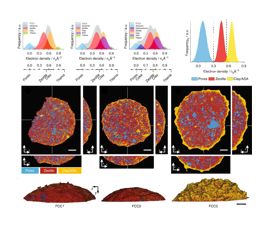Chemistry
Oil refinery catalyst deactivation analysis

Combination of x-ray techniques reveals structural changes that lead to catalyst deactivation.
Since its commercial introduction three-quarters of a century ago, fluid catalytic cracking has been one of the most important conversion processes in the petroleum industry providing the majority of the world’s gasoline fuel.
In this process, porous composites composed of zeolite and clay crack the heavy fractions in crude oil into transportation fuel and petrochemical feedstocks. Yet, over time the catalytic activity of these composite particles decreases. With major refineries requiring up to 40 tons of fresh catalyst on a daily basis there is a constant interest in prolonging the lifetime and improving the performance of these composites.
Common catalysts in fluid catalytic cracking (FCC) are spherical composites, 50–150 µm in diameter, formed by spray drying. They are composed of ~15–50% rare earth-stabilized Y-type zeolite, a crystalline aluminosilicate, a functional matrix of calcined kaolinitic clay, an amorphous aluminosilicate, and a binder composed of alumina and/or silica.
During FCC unit operation, composites are exposed to rapidly cycling temperatures up to 750 ºC. After cracking, the composites are transferred to a regenerator. In the regenerator, coke deposits cause a transitory deactivation of the catalyst. These are burned off and the regenerated composites are returned to the unit, and the process repeats.
Working in partnership with W. R. Grace Refining Technologies, a combination of x-ray ptychographic tomography, x-ray diffraction, and x-ray fluorescence tomography, combined with electron microscopy measurements, has been used to determine the structural changes that lead to catalyst deactivation.
In combination, these measurements reveal zeolite amorphisation and structural changes on the particle exteriors as the driving forces behind catalyst deactivation. A concretion of the outermost particle layer into a dense amorphous silica–alumina shell further reduces the mass transport to the active sites within the composite.
Based on these observations, options for catalyst regeneration and redesign are being explored.
References
A three-dimensional view of structural changes caused by deactivation of fluid catalytic cracking catalysts
Ihli J, Jacob RR, Holler M, Guizar-Sicairos M, Diaz A, Silva JCd, Sanchez DF, Krumeich F, Grolimund D, Taddei M, Borca C, Cheng W-C, Shu Y, Menzel A, van Bokhoven JA
Nature Communications. 2017;8:809.
https://doi.org/10.1038/s41467-017-00789-w
